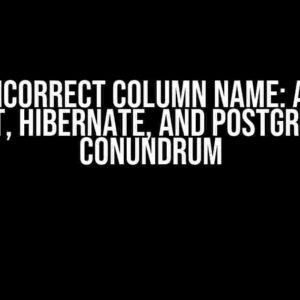Welcome to this in-depth tutorial on integrating Apache Ignite 2.16.0 REST API with a Spring Boot 2.7.18 application! Are you tired of dealing with the complexities of distributed systems and caching? Look no further! In this article, we’ll take you by the hand and guide you through the process of setting up Apache Ignite’s REST API on a Spring Boot application, along with configuring the Jetty version. By the end of this journey, you’ll be equipped with the knowledge to unlock the full potential of Apache Ignite and supercharge your application’s performance.
What is Apache Ignite?
Apache Ignite is an open-source, in-memory computing platform that provides a robust and scalable caching solution for distributed systems. It allows you to accelerate your application’s performance by offloading computations and caching data in memory, reducing the load on your database and improving overall system efficiency.
Why Use Spring Boot?
Spring Boot is a popular Java-based framework that enables rapid development of robust, scalable, and production-ready applications. Its auto-configuration and starter dependencies make it an ideal choice for building RESTful APIs, microservices, and cloud-native applications. By combining Spring Boot with Apache Ignite, you can create a high-performance, distributed system that meets the demands of modern computing.
Setting Up the Project
To get started, create a new Spring Boot project using your preferred IDE or by using the Spring Initializr tool. Choose the “Web” and “Ignite” dependencies, and set the Spring Boot version to 2.7.18.
<dependencies>
<dependency>
<groupId>org.springframework.boot</groupId>
<artifactId>spring-boot-starter-web</artifactId>
</dependency>
<dependency>
<groupId>org.apache.ignite</groupId>
<artifactId>ignite-spring-boot-starter</artifactId>
</dependency>
</dependencies>
Configuring Apache Ignite
In the `application.properties` file, configure the Ignite cache and Jetty version as follows:
ignite.cache.default.cache-mode=REPLICATED ignite.jetty.version=11.0.12
In the `application.yml` file, define the Ignite configuration:
ignite:
cache:
default:
cache-mode: REPLICATED
jetty:
version: 11.0.12
Explaining the Configuration
ignite.cache.default.cache-mode=REPLICATED: Configures the default cache mode to REPLICATED, which ensures that data is replicated across all nodes in the cluster.ignite.jetty.version=11.0.12: Specifies the Jetty version to use with Ignite.
Creating the REST API
Create a new REST controller to interact with the Apache Ignite cache:
@RestController
@RequestMapping("/api")
public class IgniteController {
@GetMapping("/cache")
public String getCache() {
IgniteCache<Integer, String> cache = Ignition.start().getOrCreateCache("myCache");
String value = cache.get(1);
return "Cache value: " + value;
}
@PostMapping("/cache")
public String putCache(@RequestBody String value) {
IgniteCache<Integer, String> cache = Ignition.start().getOrCreateCache("myCache");
cache.put(1, value);
return "Cache updated successfully!";
}
}
Explaining the Code
IgniteCache<Integer, String> cache = Ignition.start().getOrCreateCache("myCache");: Creates an instance of the Ignite cache.String value = cache.get(1);: Retrieves a value from the cache using the cache key.cache.put(1, value);: Updates the cache with a new value.
Running the Application
Start the Spring Boot application and access the REST API endpoints using a tool like Postman or cURL.
http://localhost:8080/api/cache
http://localhost:8080/api/cache (POST request with JSON body {"value": "Hello, Ignite!"})
Troubleshooting and Optimization
Common issues to watch out for when working with Apache Ignite and Spring Boot:
| Error | Solution |
|---|---|
| Ignite cache not starting | Check the Ignite configuration and ensure that the cache is properly defined. |
| Jetty version conflict | Verify that the Jetty version specified in the configuration matches the version used by Spring Boot. |
| Performance issues | Tune the Ignite cache settings, such as the cache size, expiration policy, and data loading strategy, to optimize performance. |
Conclusion
And that’s it! You’ve successfully integrated Apache Ignite 2.16.0 REST API with your Spring Boot 2.7.18 application. By following this guide, you’ve taken the first step in unlocking the full potential of Apache Ignite and supercharging your application’s performance. Remember to optimize your Ignite configuration and troubleshoot any issues that arise. Happy coding!
Bonus tip: Explore the Apache Ignite documentation and Spring Boot tutorials for more advanced features and use cases.
Keywords: Apache Ignite, Spring Boot, REST API, Jetty, caching, distributed systems, performance optimization.
Frequently Asked Question
Get the scoop on Apache Ignite 2.16.0 REST API on Spring Boot 2.7.18 application, and discover the perfect jetty version to pair with it!
What is the recommended way to integrate Apache Ignite 2.16.0 REST API with a Spring Boot 2.7.18 application?
To integrate Apache Ignite 2.16.0 REST API with a Spring Boot 2.7.18 application, you should use the Apache Ignite Spring Boot Starter. This starter provides auto-configuration and enables Ignite nodes to be started as part of your Spring Boot application. Simply add the Ignite Spring Boot Starter dependency to your project’s pom.xml file, and you’re good to go!
How do I configure the Apache Ignite 2.16.0 REST API in my Spring Boot 2.7.18 application?
To configure the Apache Ignite 2.16.0 REST API, you can create a configuration file named ‘ignite.xml’ in your project’s classpath. This file should contain the necessary settings for your Ignite node, such as the node name, IP finder, and cache configurations. You can also use Spring Boot’s application.properties file to externalize configuration properties.
What is the recommended Jetty version to use with Apache Ignite 2.16.0 and Spring Boot 2.7.18?
The recommended Jetty version to use with Apache Ignite 2.16.0 and Spring Boot 2.7.18 is Jetty 9.4.x. This version is compatible with both Ignite and Spring Boot, ensuring a seamless integration and optimal performance.
Can I use Apache Ignite 2.16.0 REST API with other web servers besides Jetty?
Yes, you can use Apache Ignite 2.16.0 REST API with other web servers besides Jetty. Ignite provides a Rest API that can be deployed on any Servlet 3.1+ compliant container, including Tomcat, Undertow, or others. However, keep in mind that some web servers might require additional configuration or customization to work seamlessly with Ignite.
Are there any known issues or limitations when using Apache Ignite 2.16.0 REST API with Spring Boot 2.7.18?
Yes, there are some known issues and limitations when using Apache Ignite 2.16.0 REST API with Spring Boot 2.7.18. For example, you might encounter issues with Ignite’s logging configuration or experience compatibility problems with certain Spring Boot features. Be sure to check the official documentation and release notes for both Ignite and Spring Boot to stay informed about any potential issues or limitations.


